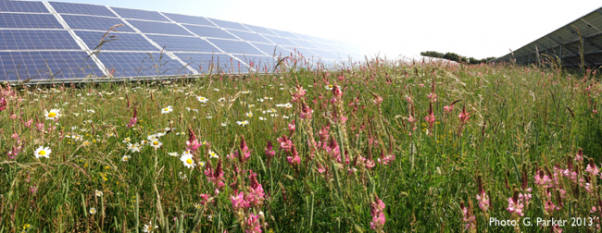
The costs of solar are rapidly falling and voter support for clean energy is growing — but what about the boots-on-the-ground situation? How is it going for solar projects securing zoning and planning support and the local permits that allow these projects to be built?
It’s mixed. Like Stearns County near Minneapolis-St. Paul, most communities are leaning forward and approving or creating workgroups to address solar site permitting concerns. A few counties, such as a county adjacent to Stearns and others nationwide, are being driven to implement solar moratoriums by people making claims about the use of land in farming areas.
Minnesotan’s agricultural leaders recognize that solar is part of the rural landscape, and, working in partnership with Fresh Energy, Audubon Minnesota, and business and conservation groups, have established a new state-wide standard for use of the land under and around ground-mounted solar panels.
Authored by agriculture leaders Representative Rod Hamilton (R–Mountain Lake) and Senator Dan Sparks (DFL–Austin), HF 3353, will meaningfully help Minnesota’s bees, monarchs, pheasants, and songbirds, by providing abundant, high-quality foraging habitat on solar sites. These land management practices will also improve the quality of the soil on these sites and help channel water down into the aquifer — significant benefits in the agricultural landscape.
HF 3353 passed the Minnesota House by a vote of 126-0 and the Minnesota Senate by a vote of 62-2. The bill language refers to two documents:
- Prairie Establishment & Maintenance Technical Guidance for Solar Projects (Minnesota Department of Natural Resources)
- Solar Site Pollinator Habitat Assessment (A worksheet in the Minnesota Board of Water and Soil Resources’ Pollinator Plan)

Both House and Senate versions of the bill had strong bi-partisan support, as well as support from rural, suburban, and urban legislators. The bills’ co-authors were: Rep. Peggy Bennett (R–Albert Lea), Rep. Connie Bernardy (DFL–New Brighton), Rep. Sondra Erickson (R–Princeton), Rep. Jason Isaacson (DFL–Shoreview), Sen. John Marty (DFL-Roseville), Sen. Jeremy Miller (R–Winona), Rep. Jeanne Poppe (R–Austin), and Rep. Barb Yarusso (DFL–Shoreview).
The coalition actively supporting the bill included Albert Lea Seed Co., Audubon Minnesota, Anderson Corporation, Enel Green Power, Minnesota Corn Growers Association, Minnesota Farmers Union, the pollinator working group at Minnesota Environmental Partnership, Prairie Moon Native Plants, and Prairie Restorations. Despite a short and hectic legislative session, this coalition of agriculture, conservation, and energy leaders held strong and secured a broad bipartisan win for the bill.
Though the legal standard only applies to solar projects that are promoted as providing benefits to pollinators, songbirds, or game birds, it is a clear signal to the solar industry regarding vegetative cover as a preferred practice.
